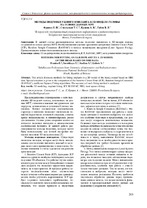| dc.contributor.author | Франко, Е. П. | ru |
| dc.contributor.author | Смольская, Т. С. | ru |
| dc.contributor.author | Кудина, А. В. | ru |
| dc.contributor.author | Габец, В. Л. | ru |
| dc.coverage.spatial | Минск | ru |
| dc.date.accessioned | 2025-02-05T12:16:45Z | |
| dc.date.available | 2025-02-05T12:16:45Z | |
| dc.date.issued | 2024 | |
| dc.identifier.citation | Методы подгонки ушного импланта к 3D-модели головы на основе данных МРТ = Methods for fitting an ear implant to a 3D model of the head based on MRI data / Е. П. Франко, Т. С. Смольская, А. В. Кудина, В. Л. Габец // Приборостроение-2024 : материалы 17-й Международной научно-технической конференции, 26-29 ноября 2024 года, Минск, Республика Беларусь / редкол.: А. И. Свистун (пред.), О. К. Гусев, Р. И. Воробей [и др.]. – Минск : Интегралполиграф, 2024. – С. 283-284. | ru |
| dc.identifier.uri | https://rep.bntu.by/handle/data/153110 | |
| dc.description.abstract | В данной статье рассматриваются методы подгонки имплантов к 3D-модели головы, созданной на основе данных МРТ. Особое внимание уделено сравнению алгоритмов Iterative Closest Point (ICP), Random Sample Consensus (RANSAC) и метода наименьших квадратов (Least Squares Fitting). Проведен анализ точности подгонки каждого метода. | ru |
| dc.language.iso | ru | ru |
| dc.publisher | Интегралполиграф | ru |
| dc.title | Методы подгонки ушного импланта к 3D-модели головы на основе данных МРТ | ru |
| dc.title.alternative | Methods for fitting an ear implant to a 3D model of the head based on MRI data | ru |
| dc.type | Article | ru |
| local.description.annotation | This article discusses methods for fitting implants to a 3D model of the head, created based on MRI data. Special attention is given to the comparison of the Iterative Closest Point (ICP), Random Sample Consensus (RANSAC), and Least Squares Fitting algorithms. The accuracy of each fitting method is analyzed. | ru |

